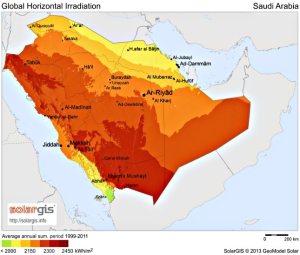Two researchers, Guiseppe Franchini and Antonio Perdichizzi, from the University of Bergamo have proposed an alternative cooling technology; using a thermal form of solar energy to provide solar district cooling in the Kingdom.
Their study of the economics of solar district cooling was published at Energy Conversion and Management, in Performance prediction of a solar district cooling system in Riyadh, Saudi Arabia – a case study.
“So this technology could be interesting also for other locations like in the Mediterranean. In Italy for example, cooling loads are increasing more and more with the higher temperatures in the summer. So this technology can have a good application also in other countries,” said Franchini.
Early in their investigation, Perdichizzi and Franchini determined that solutions based only on PV exhibit some weakness points: the main critical issue is related to the electric storage by batteries for large size systems. So their focus became solar thermal technologies.
“Our investigation was comparing solar district cooling from parabolic trough collectors or solar cooling from evacuated tube collectors,” said Perdichizzi.
“One is based on single stage absorption chiller driven by evacuated tube collectors operating at medium temperatures. The second one is based on two stage absorption chillers driven by parabolic troughs operating at a higher temperature around 170°C.”
Since an absorption chiller does not require very high temperatures for cooling (about 170°C for double-stage and 100°C for single-stage), the obvious choice would seem to be the typical solar thermal rooftop collectors, such as is popularly used to heat swimming pools or to make hot water in homes at comparatively low temperatures.
Yet after comparing the two, they found that a parabolic trough solar field would be the most economical.
“Our proposed solution is a solar district cooling system for new settlements in Saudi Arabia. This concept combines solar cooling and district cooling,” said Franchini.
The study has implications for the climate. With one of the world’s highest per capita energy consumption rates, cooling accounts for more than 70% of electricity use in Saudi Arabia’s year-round hot climate.
But the Kingdom still produces this electricity almost entirely using fossil fuels, despite its abundant solar resource.


